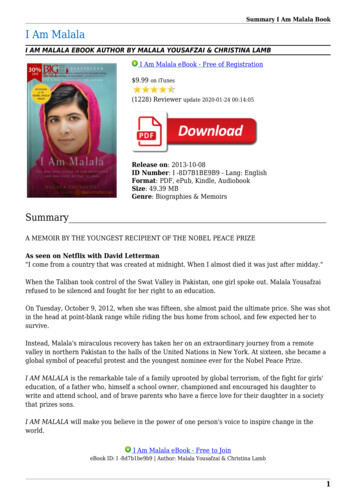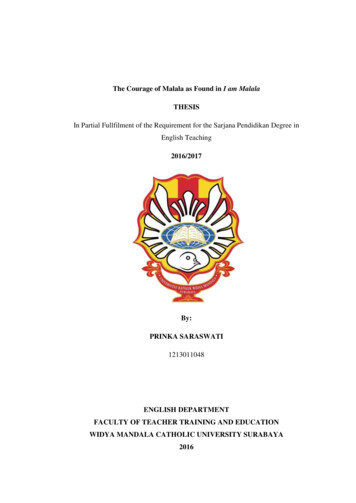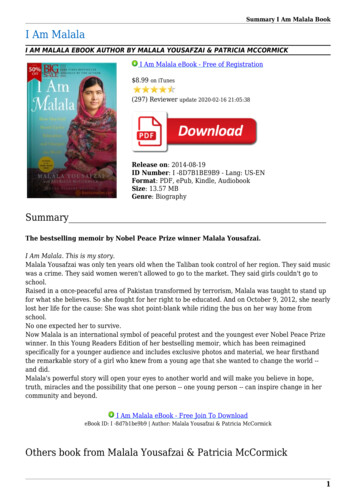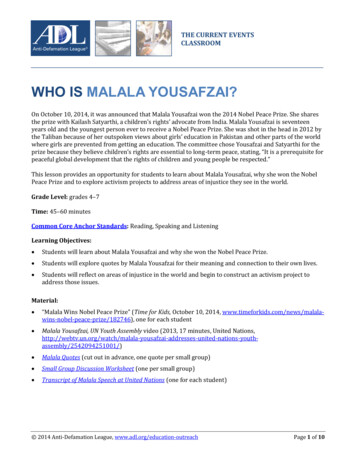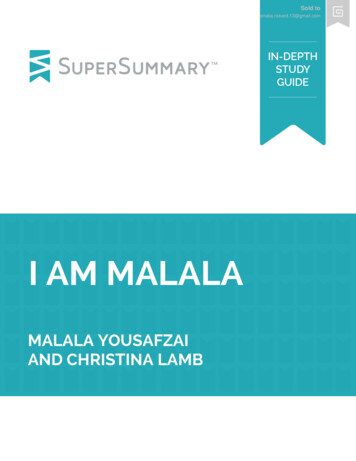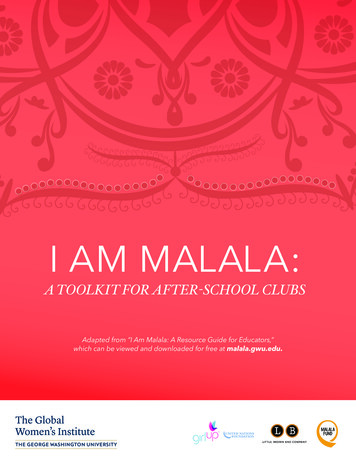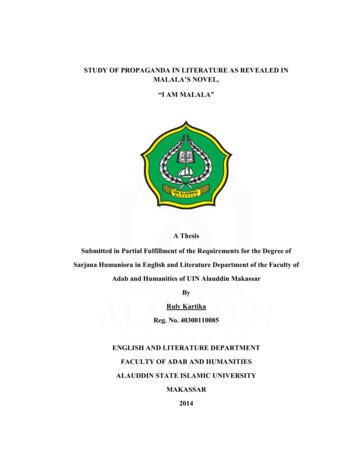
Transcription
MALALA YOUTH VOICESTUDENT TOOLKITCONTENTSToolkit overview3Competition instructions and prizes4Malala Yousafzai and the Malala Fund5Campaigning6Campaign planning activity sheet7Writing and making speeches8Speechwriting activity sheet9Strapline-writing activity sheet10Filmmaking11–12Storyboard activity sheet13–14Social media – uploading andpromoting your film15–172
MALALA YOUTH VOICESTUDENT TOOLKITTo celebrate the cinema release of the film HeNamed Me Malala, National Schools Partnershipand Into Film with Fox Searchlight have launchedthe Malala Youth Voice competition.If you’re aged between 13 and 19 and you live inthe UK, this is your chance to raise your voice tomake a difference like Malala. How? By makingyour own short film!MALALA SAID“I raise up my voice, not so I canshout, but so that those withouta voice can be heard There’s a bunch of brilliant prizes for the bestfilms, including a trip to London for an exclusivefilm screening, iPads, copies of Malala’s inspiringbook and a Fox DVD bundle. So get your cameras,smartphones and tablets ready When the world is silent, evenone voice becomes powerful.”This useful toolkit will help you plan, make, enter andpromote your film for the competition.It’s really easy to enter, but do read all the tips andguidance so you’ll have the best chance of winning.Get inspired!First things first, watch the He Named Me Malala trailerand some example campaign films ke sure you read the rules too!Get making!There are twodeadlinesfor thecompetition:Your film must be entered by5pm, 13th November 2015Public voting for your films closes atmidday, 20th November 20153
MALALA YOUTH VOICESTUDENT TOOLKITCOMPETITION INSTRUCTIONS AND PRIZESWhat do you have to do?5. Public voting closes at midday, 20th November2015. The 10 films with the most votes will beshown to a judging panel, and they’ll decide uponthe winner and runners-up.Create a short campaign film. It should either:add your voice to Malala’s and be a champion for education for girls around the world, or promote an issue you are passionate about, THE LOWDOWNON THECOMPETITIONPRIZESwhether it’s in your school, your local communityor a wider global issue. The important thing is thatit matters to you.What are the judges looking for?Does your film clearly communicate your campaign message?Does your film inspire and motivate others to support the campaign?Is your film original and creative? If your film comes first, you’ll win How do you enter?A trip to London (including a 2 night stay) for a private and exclusive screening at 20thCentury Fox HQ in Soho Square1. Make your short campaign film (it can beanywhere between 6 and 60 seconds)An iPad Air 2 – 64GB with Wi-Fi Copies of Malala’s inspiring book for 2. Upload it to Instagram, Vine or YouTube (readpage 15 for details)everyone in your class3. Go to www.nationalschoolspartnership.com/malalacomp to enter the competition by 5pm,13th November 2015. You’ll need to provide theInstagram, Vine or YouTube link to your film, alongwith your parent, guardian or teacher’s emailaddress so they can give their consent.A Fox DVD bundle If you’re one of the two runners-up,you’ll win An iPad Air 2 – 64GB with Wi-Fi A copy of Malala’s inspiring book 4. Your parent, guardian or teacher will receive aconfirmation email to say your entry is live. That’swhen you need to start promoting your film likecrazy! Use #MalalaYouthVoice to get your friends,family and members of the public voting for yourfilm.4
MALALA YOUTH VOICESTUDENT TOOLKITMALALA YOUSAFZAI AND THE MALALA FUND CAMPAIGNWho is Malala?MALALA SAYSMalala Yousafzai is a leading campaigner for the millions of girls worldwide who arebeing denied an education.She was born in 1997 in Mingora, in the Swat district of North West Pakistan.Her father is a poet and educational “I had two options. One was to remainsilent and wait to be killed. The secondwas to speak up and then be killed.I chose to speak up.”advocate who ran her school, whichsparked her passion for education.In 2009, after the Taliban issued a law banning girls from attending school, shewrote an anonymous blog for the BBCexpressing her views on education and lifeunder the threat of the Taliban.Malala continued to speak up for her right to attend school and won Pakistan’s firstNational Youth Peace Prize.“Let it be the lasttime we see achild deprived ofeducation. Let it endwith us.”“Now it is time tocall on them [worldleaders] to take actionfor the rest of theworld’s children.”The Taliban voted to kill her and she was shot in the head, aged 15, when travellinghome on the bus from school.Miraculously, she survived, and she now lives in the UK. She set up the Malala Fund to campaignfor quality secondary education for all girls.In 2014, she was the youngest person to win the Nobel Peace Prize and gave aninspiring speech. Malala marked her 18th birthday byopening a school for girls in Syria.He Named Me Malala, a documentary film about her life, is released in cinemas on6th November 2015.Watch the inspiring trailer here: e child,one teacher, one book,one pen can changethe world.”What is Malala’s charity campaign for?The Malala Fund is all about making suregirls achieve their potential by giving them access togood-quality secondary-school education. It’s about inspiringpositive change in local communities, and currently the fundsupports girls’ education projects in six countries.Did you know?There are over 60 million girls out of school around the worldThe average time the poorest girls spend in education is three yearsGirls have faced violence for trying to go to school in 70 countries across the globeFind out more: www.malala.orgWatch a selection of Malala’s inspiring speeches:www.youtube.com/user/MalalaFund5
MALALA YOUTH VOICESTUDENT TOOLKITCAMPAIGNINGTiming is crucialWhat is a campaign?Time your campaign release so it links up withother activities taking place. This may require someresearch to make sure you’re keeping up with currenttrends linked to your idea.A campaign is an organised activity orset of activities carried out to achievean aim. It works by:Know your target audienceThere isn’t one special recipe that magically worksfor all campaigns. You’ll need to research your targetaudience and think about the best ways to appeal tothis group of people. For example, you might want toreach young people by using social media.raising awareness of an issue you are passionate aboutpersuading others to help you bring about changePublicity and marketing influencing behaviour and opinionTop tips for campaign successA clear message is key to your success. Do you havea catchy strapline to promote your idea? Have youcreated a memorable brand or logo? Your audienceshould be able to understand your message straightaway. Make sure your messaging is consistent anddon’t forget to double-check your spelling.Knowledge is powerCommunicationIn order to run a successful campaign, it’s importantto know all about the issue you’re campaigning for.You must be able to support your argument with lots offacts!How will you deliver your message to your targetaudience? Think about all your options. Somemethods will need a budget, while some arecompletely free, such as social media, emails andword of mouth.Planning is keyEvaluateIt’s important to plan your campaign before you launchit. Think about what you want to achieve. You canuse the template on the next page to support yourplanning.Set clear targets at the beginning of your campaign.You’ll then be able to check your progress andevaluate the impact your campaign is having.6
MALALA YOUTH VOICESTUDENT TOOLKITCampaigncauseWhat do you want tocampaign about and why?CAMPAIGN PLANNINGUse this flow chart to help planyour campaign. It will help yousort all your ideas into a logicalorder before you create your filmto deliver your message.OutcomesWhat do you want toachieve?Make notes inside each bubbleTimingsWhen will you launchyour campaign?TargetaudienceWho are you tryingto influence?MarketingWhat is your messageand is it clear?CommunicationWhat tools will you use?Eg social media, postersEvaluateHow will you measuresuccess?7
MALALA YOUTH VOICESTUDENT TOOLKITWRITING AND MAKING SPEECHESTen tips for speech success5 Keep it simple: use straightforward language andshort sentences – they work better for engagingaudiences and keeping their interest.1Know your topic: research your subject matter soyou know what you want to say. You’ll come acrossas confident and passionate if you can back up yourargument with facts.6 Build emotion into your speech: a loud and clearvoice is great for speeches, but no one likes beingshouted at. Remember you’ll need to change tone toemphasise key points.2 Plan your speech: figure out what your opening,main points and conclusion are going to be beforeyou start writing. Jot down all your thoughts, then putthem in a clear order so your speech flows in a logicalsequence. If the audience loses your train of thought,they’ll stop listening. Don’t know where to start? Trythinking about your conclusion first.7 Make only three main points: having too much tosay will confuse your audience. Keep your argumentto just three key ideas.8 3 Use props: tools like PowerPoint can be very useful ifyou want to use images or videos to help illustrate keyelements of your speech. Just don’t use too much text.You want the audience to listen to your voice. now your audience: make sure the language youKuse in your speech is appropriate for the people inyour audience. You need to think about their age,where they come from, what their existing knowledgeis of the subject and so on.9 4 Consider ways of engaging with the audience:how could you get your audience to participate? Thinkabout everything from a simple show of hands to aquestion-and-answer session using electronic devices.Timing is crucial: be clear about the length of yourspeech. It needs to be punchy and hold the audience’sattention. Once you’ve got your first draft written, timeit as you read it out loud. Remember your MalalaYouth Voice competition film must be between 6 and60 seconds.10 reate one take-away line: what one key phraseCwould you like to stick in your audience’s minds afterthey’ve heard your speech?8
MALALA YOUTH VOICESTUDENT TOOLKITSPEECHWRITING ACTIVITY SHEETCreate a winning campaign speech and use the bestbits for your campaign film for the Malala Youth Voicecompetition.Write notes inside each boxWhat’s the title of your speech/campaign?Make it short and catchy.What are your three main points?Explain the issue, why your campaign isneeded and how it will help.Support your arguments with facts.What’s your opening line?Make it a winner – it needs to to grab theaudience’s attention.Who are you?Introduce yourself and explain why you’respeaking up.What’s your take-away message?Finish with a sentence to spur people into action.9
MALALA YOUTH VOICESTUDENT TOOLKITSTRAPLINE-WRITING ACTIVITY SHEETCreate the perfect strapline to use in your MalalaYouth Voice campaign film and promote yourcompetition entry on social mediaWhat is a strapline?A strapline is a very short sentence that describes yourcampaign in a nutshell. It needs to be punchy, so yourtarget audience instantly understands and remembersyour campaign.Here are some tips for creating amemorable campaign strapline:Here are some examples of impactful straplines:Be clear about what you are trying to say. Keep it simple, but unique. Make sure it’s an honest representation of Charity straplines O ne child, one teacher, one book, and one pencan change the world – Malala Fundyour campaign message and your film. N o child born to die – Save the ChildrenFor every child in danger – Unicef B e Humankind – OxfamCheck it will entice the audience, invoke emotion and make them want to stop andlisten – you can test it out on your teacher,family and friends first.Commercial straplines (they are called slogans inthe advertising world) Make sure it’s memorable – can you remember the phrase easily J ust do it – NikeH ave a break, have a Kit Kat – Kit KatE very little helps – TescoB eanz meanz Heinz – HeinzConnecting people – NokiaNow you know the rules, it’s your turn to try and comeup with your own strapline.Write your best ones in the box below:Can you think of any more well-known straplines orslogans? If not, research some online or ask friendsand family.Write your favourites in the box below:10
MALALA YOUTH VOICESTUDENT TOOLKITFILMMAKINGTo enter the Malala Youth Voice competition,you’ll need to create a short campaign film ofbetween 6 and 60 seconds.Our filmmaking top tips to help youcreate a winning filmYour film can either:Plan aheadIt’s very tempting to start filming straight away, butstep away from that camera! You need to spend timedeveloping your campaign first, working out how bestto communicate your message. It will help you createa much stronger film. Here’s how to get started.add your voice to Malala’s to help her promote education for all girls around the world or promote an issue that you are passionate about, whether it’s in school, your local community or awider global issue. The important thing is that itmatters to you.Make a campaign flow chart to clarify your ideas. Create a storyboard to help visualise how you will communicate your message in the film.Share your ideas with friends and ask for their The judging criteria:feedback.Less is more. A simple story told well can be very Does your film clearlycommunicate your campaignmessage?Think about your audienceDoes your film inspire andmotivate others to support thecampaign?To be in with a chance of reaching the competition effective. A complicated story with little focus couldconfuse your audience.When you’re coming up with ideas, don’t forget whoyour viewers will be. You need to use the right wordsand the right tone to engage with your audience.final, you’ll need to win the hearts and minds ofas many people as possible. Your film should befitting for a family audience, so it shouldn’t containany swearing, offensive language, drug-taking,smoking or violence. Films with this kind of contentcould be disqualified from the competition.Is your film original andcreative?Think about what will make your film appeal to Don’t be afraid to give it a goother young people.The most important thing to remember is thatfilmmaking doesn’t have to be complicated orexpensive. You probably already have the knowhow and equipment you need to do it!11
MALALA YOUTH VOICESTUDENT TOOLKITFILMMAKING [CONTINUED]MusicThink of music as your secret filmmaking weapon! Itwill help you engage your viewers on an emotionallevel, so choose well. Sadly, you won’t be able to useyour favourite pop songs or other copyrighted tracksyou like. Instead, use one of the many copyrightfree music libraries online such as Incompetech orAudioMicro. They have a variety of music tracks youcan use for free.You don’t need a lot of fancy equipmentSince smartphones and tablets came along, it’s nowperfectly possible for most people to be filmmakers!There are great filmmaking apps, many of whichare completely free to download. Just use whateverequipment you have, or ask if you can borrow fromyour friends, family or school. The most importantthings to have are imagination and enthusiasm!Or why not collaborate with the musical talent inyour school and ask them if they’d be interested incomposing music especially for your project?Get permissionSound checkIf you want to include your friends or family in yourfilm, make sure you have their permission first.When you’re making a film, don’t forget that the soundrecording is just as important as the video you shoot.Here’s what to do to make sure poor-quality sounddoesn’t spoil your masterpiece Keep your film shortThe rules of the Malala Youth Voice competition statethat your film must be between 6 and 60 seconds(including titles and credits).Avoid busy or loud areas when filming, especially if you don’t have a suitable microphone.If at all possible, use an external microphone Editing and finishingbecause the built-in mics on cameras don’t alwaysproduce quality sound.After you have filmed and shot your film, there is oneimportant element left to do: editing. Don’t be scaredto cut parts of your film out if you feel they’re notworking. If you’re unsure, the audience probably willbe too! You will find helpful guides to editing atwww.intofilm.org/filmmakingUse headphones to help you identify any issues with your sound recordings.Keep your camera as still as possibleShaky camera work is off-putting for the audience.You’ll need to look at ways to keep your camera as stilland steady as possible when you’re filming.A good-quality tripod will allow you to pan and tilt thecamera (move it horizontally and vertically) and avoidunnecessary camera shakes.For more tips visit the Into Film website:www.intofilm.org/filmmakingIf you don’t have a tripod, rest against a wall and keepyour arms still during the shoot. Or rest your cameraon a flat surface to ensure you achieve a steady shot.12
MALALA YOUTH VOICESTUDENT TOOLKITSTORYBOARD TEMPLATEAll good filmmakers create storyboards beforethey start shooting. A storyboard (a visual plan withdrawings and descriptions) will help you developyour ideas and work out what you’re going to filmfor each shot. It’s also your checklist when you’reshooting, so you can make sure you’ve filmed all theshots you need.Use the template below to create yourstoryboard. Don’t worry about your drawingskills – stick figures are just fine!If you’d like more guidance on creating a storyboard,visit Into Film’s useful web 7/how-to-storyboard-your-filmSHOT 1DURATIONLOCATIONSHOT TYPE / CAMERA MOVEMENTACTIONPROPS / EQUIPMENTSOUND / DIALOGUESHOT 2DURATIONLOCATIONSHOT TYPE / CAMERA MOVEMENTACTIONPROPS / EQUIPMENTSOUND / DIALOGUE13
MALALA YOUTH VOICESTUDENT TOOLKITSTORYBOARD TEMPLATE [CONTINUED]SHOT 3DURATIONLOCATIONSHOT TYPE / CAMERA MOVEMENTACTIONPROPS / EQUIPMENTSOUND / DIALOGUESHOT 4DURATIONLOCATIONSHOT TYPE / CAMERA MOVEMENTACTIONPROPS / EQUIPMENTSOUND / DIALOGUESHOT 5DURATIONLOCATIONSHOT TYPE / CAMERA MOVEMENTACTIONPROPS / EQUIPMENTSOUND / DIALOGUE14
MALALA YOUTH VOICESTUDENT TOOLKITSOCIAL MEDIAFor films up to 60 seconds long, choose YouTubeYouTube allows you to upload and share videos of upto 15 minutes by default. The platform has millions ofusers around the world, uploading more than 35 hoursof video every minute of every day!www.youtube.comSocial media is very popular with campaignersbecause it’s a free and immediate way to gathersupport for good causes. This guide will help you touse social networks successfully – and safely – duringthe Malala Youth Voice competition!STEP-BY-STEP GUIDE TO UPLOADING ANDPROMOTING YOUR FILMOnce you have chosen which platform is best for yourcampaign film, register for an account and upload yourfilm. Make sure your film is set as a public video. If youneed help, you’ll find it via the links below Step 7Upload your campaign film to one of three socialmedia 0612501386/If you don’t already use Vine, Instagram or YouTube,you’ll need to choose one and set up a answer/57407?hl en-GBRemember: you must be aged 13 or over in order toopen a social media account. This competition is notopen to young people under the age of 13.Which site is best?Step 2:They’re all good. Choose the one that suitsthe length of your film best! Don’t forget to use#malalayouthvoice when you upload your film to yourchosen platform.Enter your film in the competitionOnce you’ve uploaded your film to Vine, Instagramor YouTube, copy its ‘share’ link and to enter the competition.For films up to 6 seconds long, choose VineVine is a video-sharing platform where you cancapture and share 6-second-long looping video clipsand share them on Facebook, Twitter and more.https://vine.coYou’ll be asked for your parent or guardian orteacher’s email address because they’ll need to givetheir consent for you to enter. As soon as they’veconfirmed it’s okay for you to enter, your video will ‘golive’ on the competition website.For films up to 15 seconds long, choose InstagramInstagram is a social network that allows you to uploadand share videos of up to 15 seconds on Facebook,Twitter, Tumblr and Flickr.https://instagram.comDon’t forget the deadline for receiving your entryis 5pm, 13th November 2015.15
MALALA YOUTH VOICESTUDENT TOOLKITSOCIAL MEDIA [CONTINUED]Step 3:4Promote your entryTell your friends and family. They’re your readymade fan base. Use them. They want you to succeed!Once you’ve successfully entered the competition,all you need to do is promote your entry to as manypeople as you possibly can to make your voice heardusing #malalayouthvoice and get the public to votefor your film.5Start with Facebook and Twitter. People have touse a Twitter or Facebook account to vote for entrieson the microsite, which means they are very usefulnetworks to promote your entry on. You should use thenetwork you uploaded your film to as your followerscould already be enjoying your film!Voting closes at midday, 20th November 2015.After that, the official judging panel will watch the10 videos with the most votes and pick one winnerand two runners-up.6Ten tips for social media successDon’t stop there! Use every platform you can thinkof – WhatsApp, Snapchat etc as well as email, text,posters, stickers and word of mouth.17Make sure your film sounds good. People canforgive most bad video quality if the content is good.But if they can’t hear it, they’ll click away.Once is not enough. Tell people more than onceevery few days to vote for you. Not everyone is onlineall the time and lots of people will have missed yourfirst post.2Make sure your headline and description getpeople’s attention. Be snappy, be silly, but be clearabout what the content is. Use your strapline. Tag yourvideo with the right things. Include the competitionhashtag #MalalaYouthVoice, but research otherhashtags and keywords to include any that arerelevant to your content.8Don’t spam people, though! That’ll really annoythem. In the same way it annoys you when peoplespam you.93Post what you like about some of the other videos.Show you care, not only about winning, but also aboutimportant issues.Use images. When you’re sharing your film on asocial media site, include a good image of yourself –or the pre-prepared sharing image you can downloadfrom www.nationalschoolspartnership.com/malalacomp – as well as the link to your film. Visualsmake people click more!10Be nice. That’s a rule for life, but also a rule for acampaign.16
MALALA YOUTH VOICESTUDENT TOOLKITSOCIAL MEDIA SAFETY TIPSNever share your phone number, address, date During the competition, we wantto make sure you use social medianetworking safely.of birth, or pictures of your home, workplace orschool.Pick a username that does not include personal information about you.Because social media platformshave such a large amount of usersthat are unknown to us, we must becareful when promoting ourselves.Be careful which photos and videos you share on social media sites because, once you’ve putthem online, other people may be able to see anddownload them.If you want to share photos or videos of other people online, make sure you have theirpermission first.Here’s some helpful advice Use the privacy and security settings on social media sites so that only friends and family can seeinformation you wish to remain private.If you think someone is trying to access your information or befriend you and you areuncomfortable about this, close down that accountand tell your teacher/parent/guardian.Make sure you log out of accounts when you’re finished using them and shut down old accountsthat are no longer in use.Treat others online as you want them to treat you, and as you would in real life.17
one teacher, one book, one pen can change the world." "Now it is time to call on them [world leaders] to take action for the rest of the world's children." 5 MALALA YOUTH VOICE STUDENT TOOLKIT MALALA YOUSAFZAI AND THE MALALA FUND CAMPAIGN Who is Malala? Malala Yousafzai is a leading campaigner for the millions of girls worldwide who are
